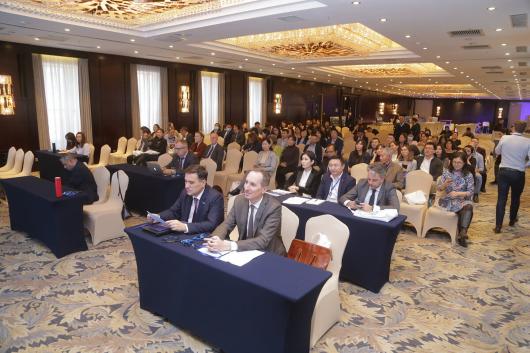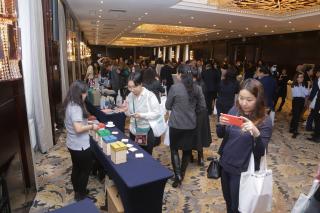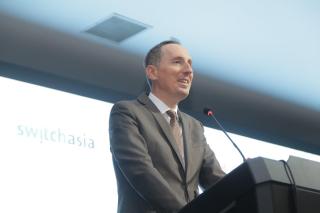
Construction Demolition Waste Management Project's Closing Ceremony
19.11.2020 / 09:37 | Aktualizováno: 19.11.2020 / 09:53
On 30 October 2020, the Closing ceremony of the “Improving Resource-Efficiency and Cleaner Production in the Mongolian Construction Sector through Materials Recovery” project, which was implemented between 2016 and 2020 with the financial support of the European Union (SWITCH-Asia program) and Czech Development Agency, was held.
The ceremony brought together the small and medium enterprises (SMEs) in the construction sector, construction material producers, Mongolian state institutions, university professors, NGOs, and private entities, donors, and stakeholders involved in the project.
"The European Union promotes sustainable development, transition towards a low-carbon, resource efficient and circular economy. In 2016 we started this project to address the issue of ever increasing construction demolition waste, which was not recycled and in most of the cases it was just dumped at illegal sites, contributing to the pollution of the environment. Today’s event is an opportunity for us to understand and highlight achievements of the project and discuss further sustainability of the project’s legacy." said H.E. Mr. Traian Laurentiu Hristea, Ambassador of the European Union to Mongolia, in his opening remarks.
The project aimed to contribute to the reduction of climate change and poverty in Mongolia by supporting local construction SMEs to switch to more resource-efficient practices. In an attempt to increase the local production of affordable construction products made from construction and demolition waste and reduce the carbon footprint of the construction sector, the Caritas Czech Republic (CCR) in Mongolia in collaboration with the research team of the Mongolian University of Science and Technology (MUST) tested and developed a new prototype of the construction material that is made from recycled construction and demolition waste. Moreover, the standards for this product have been approved by the respective authorities in Mongolia.
Furthermore, a new curriculum for construction and demolition waste management has been developed under the project and is now being taught at the MUST. Several research studies have been published and are available online for a wider audience. Apart from this curriculum, the project team successfully trained more than 3000 representatives from the construction sector on more efficient management of construction and demolition waste.
"Our colleagues and engineers of the Kharvaach Mergen LLC, which is a construction demolition company, has actively participated in the trainings and seminars organized within the framework of this project. As a result of the training, we tried to put the techniques and methods of recycling and reusing the construction and demolition waste into practice. For example, we separated wooden materials from around 38000 tons of construction and demolition waste and delivered it to about 120 households for firewood usage. In addition, we provided more than 200 trucks of soil from demolition waste to rehabilitate the broken dam in Khentii province. Furthermore, 4 facilities of the General Customs Administration were demolished and 85% of them were reused to build the Sports facility of the Selenge province. There are many such examples. Therefore, I would like to express my gratitude to the project team for their contribution to the Mongolian construction sector." said Lkhagvajav M., director of Kharvaach Mergen LLC.
Furthermore, the project also achieved a change in the Mongolian legal framework. "Procedure on cleaning, collecting, segregating, transporting, recycling, recovering, disposing and landfilling of construction and demolition waste" is an important step towards the sustainable development of the Mongolian construction sector. It has been approved by the Ministry of Construction and Urban Development and the Ministry itself became an advocate of the project objective.
"The Czech Republic and Mongolia have been working together in the construction sector traditionally. Czech and Mongolian construction engineers and workers built the First hospital or leather processing plant in Ulaanbaatar, cement factory in Darkhan, post office in Bayan Ulgii and other public service buildings in the country. This project has included a study trip of 16 Mongolian experts from different ministries, SMEs and NGOs to the Czech Republic. It was on the basis of this trip that the new procedure on waste management was finalized. The Czech Republic has gone through this development and has a lot to share and do together with Mongolia, including delivering relevant technologies and equipment", said H.E. Mr. Jiří Brodský, Ambassador of the Czech Republic to Mongolia, in his opening remarks.
"The project has achieved all of its expected results. Moreover, I can honestly say that it has overachieved some of its results. In particular, the number of experts in the construction sector who have been trained and the number of awareness-raising activities organized has exceeded our expectations. Now, what’s important? It’s the sustainability of the results in the future. Our project team has worked hard to make sure that the construction sector will become greener and more sustainable. However, it will not be possible to keep the project sustainability without the support of SMEs, employees in the construction sector, and the public since the construction sector's development is booming year by year. Thus, I would like to encourage you to reduce waste, reuse the construction materials, and recycle it even more efficiently so that it will not end up in a landfill" , emphasized Jana Žilková, Head of the CCR in Mongolia.
The project was implemented in collaboration with three project partners: Mongolian National Recycling Agency, Mongolian University of Science and Technology, and the Delft University of Technology from the Netherlands.






